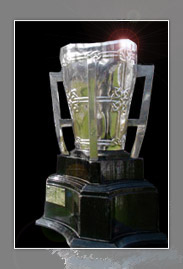As Kilkenny aim for a historic five-in-a-row, Tipperary chief Liam Sheedy has confirmed his team will remain unchanged for Sunday’s All-Ireland Senior Hurling Final against their old rivals.
Tipperary Team: B Cummins, P Stapleton, P Curran, M Cahill, D Fanning, C O’Mahony, Padraic Maher, B Maher, S McGrath, G Ryan, Patrick Maher, J O’Brien, N McGrath, E Kelly, L Corbett.
Twelve of the present side which played in last year’s decider against Kilkenny will again start at Croke Park, with Gearoid Ryan, Michael Cahill and Patrick ‘Bonner’ Maher the only new faces this year, replacing Pat Kerwick, James Woodlock and Seamus Callanan.
Padraic Maher is now at wing-back, Paul Curran is at full-back and former wing-back Brendan Maher is now starring at midfield.
Noel McGrath is again named at corner forward, alongside Lar Corbett and Eoin Kelly, while John O’Brien retains his place after his recent outstanding game against Waterford.
The Liam McCarthy Cup
The Liam McCarthy Cup is the trophy awarded annually by the Gaelic Athletic Association to the hurling team that wins the All-Ireland Senior Hurling Championship, perhaps GAA fans will spare a thought for the man whose name this cup bears.
Liam’s parents, Eoghan and Brigid MacCarthy, emigrated from Ballygarvan,Co. Cork and settled on the South bank of the Thames in 1851, on the site now occupied by the County Hall.
Eoghan was a sportsman, athlete and wrestler, known as ‘MacCarthy Capall’ or MacCarthy the Horse and spoke mostly Irish, having very little of the English language.
His son Liam MacCarthy was born in London on the 21st May 1853 and at the age of 14 he was playing hurling on Clapham Common. In his early years to earn his living he worked as a blacksmith’s hammer man on the railways.
In 1875, aged 22 years and while living at 1 Derwent Street, Peckham, Liam married Alice Padbury at St. George’s Cathedral, Southwark. London. Alice was the thirteenth child of William Padbury who owned a Fancy Box factory at 176 Blackfriars Road, Southwark, South London. Liam joined the firm but did not get on with his new in laws. He eventually broke away from this employment and with the help of his wife and his eldest son, William, the MacCarthys started making cardboard boxes on their kitchen table. The family had now moved to 48a Forest Hill Road, East Dulwich, SE 23 and his home soon became a meeting place for many Irish emigrants seeking work or place to stay.
Through this connection he became friendly with one Michael Collins who was Secretary of the London G.A.A. at the same time as Liam was chairman of the London County Board. In the summer of 1919, Collins was elected President of the IRB and acting as de facto Minister for Finance, Collins had begun established a National Loan fund, primarily to raise funds for the operation of the Irish Volunteers who around this time became known as the Irish Republican Army. McCarthy was appointed London treasurer for the National Loan fund which, by the end of August, had amassed £250,000 or €13 million in today’s currency.
In conjunction with his two sons, William and Eugene, Liam donated a sum of £50, or €2,700 for the purchase of ten Certificates to this National Loan, and when the loan was later redeemed, Liam used this money for the purchase of a silver cup based on the design of an ancient Gaelic Meither or Irish loving cup.
This cup was offered to the Central Council of the G.A.A. at Croke Park, Dublin and was gratefully accepted as the trophy to be awarded annually, and in all perpetuity, to the winners of the Senior All-Ireland Hurling Championship, to be known as The Liam MacCarthy Cup.
In 1992 the original Liam McCarthy Cup was retired and as chance would have it, Tipperary was the last team to claim the original, while Kilkenny were the first team to win the new exact replica.
This great Irishman, Liam MacCarthy, was not treated very well in his later years and he died in poverty in 1928, to be buried in an unmarked pauper’s grave at Camberwell Old Cemetery, London, where his resting place remained neglected until restored in 1990.


Leave a Reply